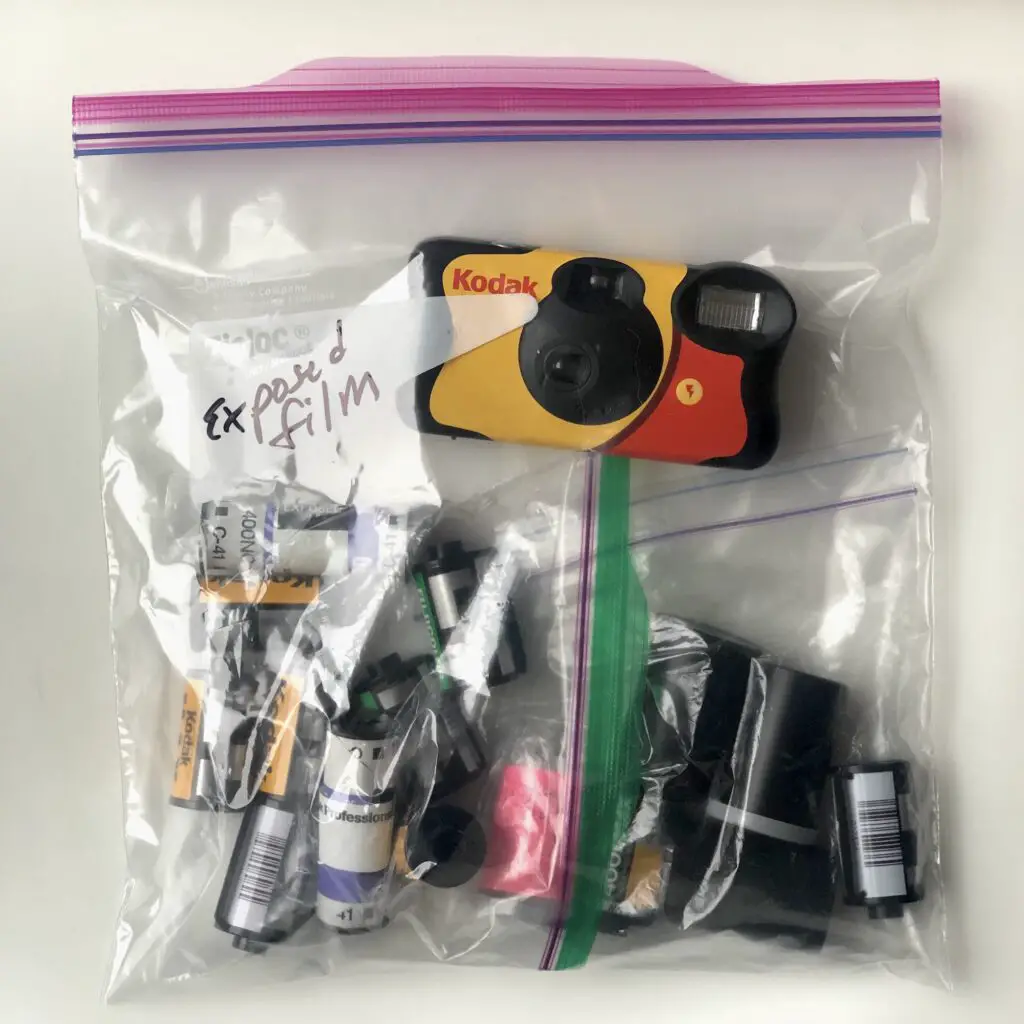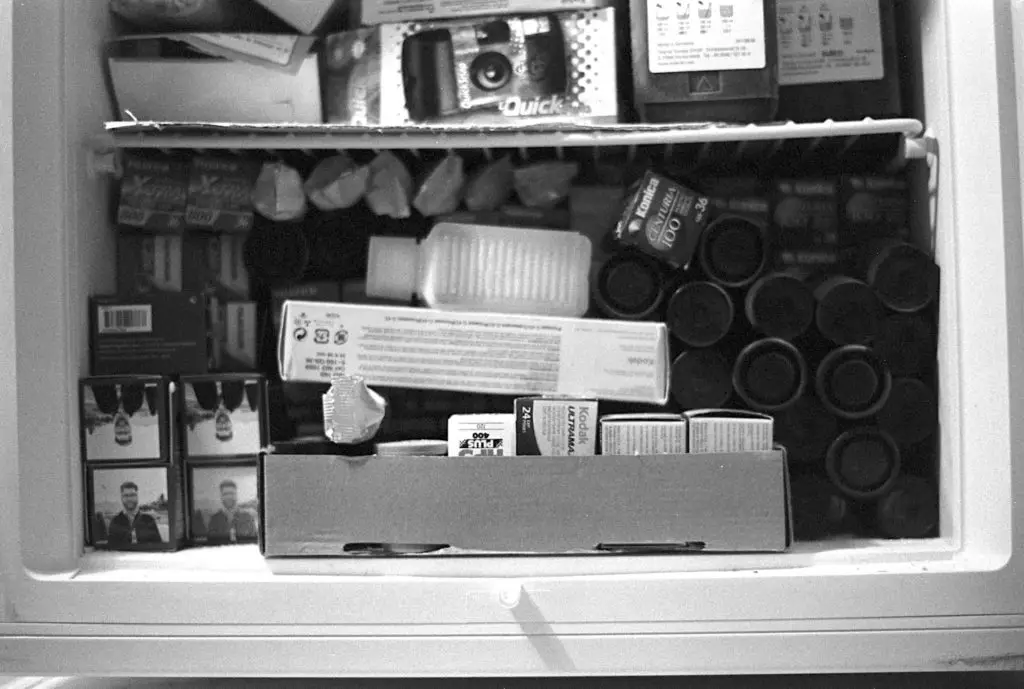As a passionate photographer, you will quickly go through many rolls of film, and knowing how long you can wait to get your film developed before developing them to obtain the best quality is crucial.
To get the best out of your color or black & white film, you should develop film the same day that it is exposed. If this isn’t possible, keep your film in a sealed container and store it in the fridge for up to 6 months before warming it up to room temperature (70 C or 21 C) and developing or sending it out for processing.
Read on to find out exactly how long you can wait to have your film developed before damage occurs, storage tips to make your film last as long as possible, and how to get the best out of your film.
How Long Does Film Last?
Photographic film and darkroom papers are products with a limited shelf life. Each roll of film has a unique expiration date that can be found on the roll itself, or on the packaging. After being manufactured, aspects of the film like sensitivity to light, contrast, color balance, and brightness will slowly change but poor storage conditions will speed up these changes. In general, color film and paper is more susceptible to this than black & white film and darkroom paper
that can be found on the roll itself, or on the packaging. After being manufactured, aspects of the film like sensitivity to light, contrast, color balance, and brightness will slowly change but poor storage conditions will speed up these changes. In general, color film and paper is more susceptible to this than black & white film and darkroom paper because of the different emulsion layers in color film.
because of the different emulsion layers in color film.
However, roll film (like 110, APS, 35mm, medium format, and sheet film) can be extended almost indefinitely by storing the film correctly in the freezer and warmed up to room temperature (70 C or 21 C) before using it or getting developing it (around 5 hours). Because of the humidity in the freezer, you will need to make an occasional check for mold or mildew growth on the film, but this should be relatively rare. Film that has been taking out the package should be used as soon as possible to avoid any effects from humidity or sunlight and developed as soon as it is exposed for best results.
NOTE: This is only for 110mm, APS, 35mm, Medium Format, or sheet film. Instant film such as Polaroid or Instax film should only be kept in the refrigerator as freezing instant film will ruin the developing chemicals in the film.
the developing chemicals in the film.
See this article for more information on how to find the expiration date on
 d
d i
i f
f f
f e
e r
r e
e n
n t
t formats
formats
 o
o f
f film
film .
.
When Should you Develop Film?
Ideally, it would be best to process your film the same day you expose it for the best results. This will give you the highest quality image with the normal levels of contrast, brightness, color, and sharpness for your film type.
However, unless you are developing your film at home it may not be possible to develop your film the same day. According to Kodak, it is best to store your exposed film in the refrigerator for up to 2 – 3 days before developing it but most films will be fine up to 6 months stored in the fridge or freezer after exposing. Make sure to keep your film in a sealed container like a plastic ziplock bag and let the film sit for 5 hours (if a single roll of film, 12 hours if a large package) to reach room temperature (70 C or 21 C) before developing your film for best results. If you are sending off your film to be developed
it may not be possible to develop your film the same day. According to Kodak, it is best to store your exposed film in the refrigerator for up to 2 – 3 days before developing it but most films will be fine up to 6 months stored in the fridge or freezer after exposing. Make sure to keep your film in a sealed container like a plastic ziplock bag and let the film sit for 5 hours (if a single roll of film, 12 hours if a large package) to reach room temperature (70 C or 21 C) before developing your film for best results. If you are sending off your film to be developed at a professional lab
at a professional lab , don’t put it into a metal mailbox because the heat may degrade your film.
, don’t put it into a metal mailbox because the heat may degrade your film.
By keeping your film in a cold environment, you can prolong the film’s degradation. However, this is only a short-term solution since your film will start deteriorating and changes will begin to occur to the latent image if left in there for more than 6 months. Keep in mind that prompt development of your film is still recommended if you wish to achieve the highest quality negatives and print.
How Long Does An Unused Roll of Film Last?
Fortunately, it is very easy to know how long an unused roll of film lasts because of the expiration date printed on the roll itself or the packaging .
.
An unopened roll of film will last until the expiry date and is protected by the packaging from environmental hazards like high-relative humidity and chemical fumes that can damage the film. Film needs to be kept below 60% relative humidity and kept away from chemical fumes such as motor exhausts, paints, solvents, cleaners, mothballs, glues, mildew and fungus preventives, foam-injected insulation, fabric treatments such as permanent press and stain inhibitors, and insecticides.

Expired film, film not stored properly and came into sustained contact with high-relative humidity, high heat (over 70 F or 21 C) and/or with the above chemical fumes can lower the film quality and mimic fogging with gradually fading the colors and color balance, contrast, and brightness of the image as the film becomes more and more out of date.This is why film a good place to store film is in a refrigerator (for all film including instant film) or a freezer for long term storage. Unexposed 35mm and medium format film stored in the freezer in its original packaging will last up to 15 years and still be good!
film, film not stored properly and came into sustained contact with high-relative humidity, high heat (over 70 F or 21 C) and/or with the above chemical fumes can lower the film quality and mimic fogging with gradually fading the colors and color balance, contrast, and brightness of the image as the film becomes more and more out of date.This is why film a good place to store film is in a refrigerator (for all film including instant film) or a freezer for long term storage. Unexposed 35mm and medium format film stored in the freezer in its original packaging will last up to 15 years and still be good!
How Long Does An Exposed Roll of Film Last?
An exposed roll of film can last up to a few days after exposure, but it is recommended that you develop the film as soon as possible for best results, especially with color film. If you aren’t able to develop your film on the same day, store it in the refrigerator for up to 3 days in a sealed container, like a ziplock bag, to reduce changes in the latent image before development and letting it warm up to room temperature (70 C or 21 C) before using it (around 3 – 5 hours). You should be able to store exposed film in the freezer for up to 6 months before you see any degradation of the image on the negatives.
How Do You Store Rolls of Film?
For the best results, always use film before the expiration date that is on the package but in general, Kodak recommends
that is on the package but in general, Kodak recommends keeping temperatures low and storing your film in areas with low humidity, away from high-heat (less than 70 F or 21 C), and out of direct sunlight such a freezer or refrigerator. Unexposed film stored in their original packaging can last in the fridge or freezer up to 15 years!
keeping temperatures low and storing your film in areas with low humidity, away from high-heat (less than 70 F or 21 C), and out of direct sunlight such a freezer or refrigerator. Unexposed film stored in their original packaging can last in the fridge or freezer up to 15 years!
Make sure to let your film warm up to room temperature (70 C or 21 C) before using it to avoid bad images. To do this, set your single rolls of film out of the fridge for around 5 hours and set out a large pack of film 24 hours before opening the container or breaking the seal of the film and using it. However, there are some differences between different types of film.
Consumer Level Films and Disposable Cameras
Kodak recommends that you can store consumer color films and color disposable cameras at temperatures up to 70 F (21 C) in environments with low relative-humidity (less than 60%) and out of direct sunlight.
Color Professional Level Film:
For color professional films (like Portra 400 ), Kodak recommends that you store color films in their original and sealed packaging out of direct sunlight and high-relative humidity (less than 60%) and under refrigeration at 55 F (13 C) or lower for best results.
), Kodak recommends that you store color films in their original and sealed packaging out of direct sunlight and high-relative humidity (less than 60%) and under refrigeration at 55 F (13 C) or lower for best results.
Black & White Films:
Kodak recommends generally storing black & white film for a short time at temperatures up to 75 F (24 C) out of direct sunlight and high-relative humidity. For storage of black & white film for longer periods of time, keep to the following storage temperatures whenever possible:
For storage periods up to: | 2 months | 6 months | 12 months |
|---|---|---|---|
Store black & white films at a temperature below: | 75°F (24°C) | 60°F (16°C) | 50°F (10°C) |
Pro tip: Keep your film in its sealed packaging until you are ready to use it. This protects it from moisture and humidity.
Should I Store Film in the Fridge or Freezer?
A good way to determine whether or not to store film in the fridge or freezer is how long before you will use it. If you plan on using the film within 3 months or less than store it in the fridge so it won’t take long to warm back up to room temperature (or 70 C or 21 C). If you don’t plan on using your film for 6 months or more, then storing your film in the freezer is recommended.
How Does Temperature Affect Film?
The temperature at which your store your film rolls has a significant impact on the quality of the film. Color film and color darkroom paper are more seriously affected than black & white film and darkroom materials.
are more seriously affected than black & white film and darkroom materials.
Film and High Temperatures
Storing your film in high temperatures above room temperature at 70 F (21 C) or high humidity environment like around 60% humidity may produce unwanted changes to the print quality, such as muting the colors, lowering the contrast, lowering sharpness, and thereby reducing overall image quality.
Film and Cold Temperatures
Colder temperatures can preserve the life of both unexposed and exposed film. Unexposed consumer color films can be stored at temperatures up to 70 F (21 C) in environments with low humidity (less than 60%) and out of direct sunlight. Unexposed color professional film should be stored in the freezer or refrigerator ideally at around 55 F (13 C) to preserve the quality up to and beyond the expiration date. Unexposed black & white film should be stored for a short time at temperatures up to 75 F (24 C) out of direct sunlight and high-relative humidity or long term (12 months) at 50°F (10°C). If not, these films may produce unwanted changes to the print quality, such as muting the colors, lowering the contrast, lowering sharpness, and thereby reducing overall image quality.
Warm Up Film Before Using If Stored in Fridge or Freezer
When storing film in the refrigerator or freezer make sure to let your film warm up to room temperature (70 C or 21 C) before using it to avoid ruining your film. Frozen film is brittle and will distort your images if it is not warmed up correctly before use. To do this, set your single rolls of film out of the fridge for 5 hours and set out a large pack of film 24 hours before opening the container or breaking the seal of the film and using it.
Should I Put Film In The Fridge After Shooting?
If you can’t develop your film on the same day, you should put your film in the fridge to preserve the image quality and reduce image deterioration. Store your film in a sealed container, like a ziplock bag, and keep it in the fridge for up to 2-3 days before development for the best results. Remember to warm your film up to room temperature (70 C or 21 C) before developing for at least 5 hours for a single roll of film or 24 hours for a large pack of film and if you are sending it off to be developed at a lab not to put it into a mailbox in direct sunlight to avoid a hot environment.
not to put it into a mailbox in direct sunlight to avoid a hot environment.

Can I Keep Film In The Freezer?
It is recommended to keep film in the freezer if you plan on storing it longer than 6 months before shooting. If you have purchased bulk rolls of film and plan on shooting them in less than 6 months, then remove them from the box and keep them in the refrigerator since it won’t take as long for them to warm back up to room temperature (70 C or 21 C) as it does when stored in the freezer (4 – 5 hours vs 12 hours). For long-term storage (6 months+), put film in the freezer to keep it fresh and maintain the film’s attributes like sensitivity to light (ISO), contrast, color balance, and brightness. Keep your freezer temperature at 0 to -10’F (-18 to -23’C) for the best results and to ensure your film is frozen correctly.
Can I Load Film Straight From the Fridge or Freezer?
Frozen film is brittle and the condensation on the surface of the film will distort your images if it is not warmed up correctly before use. This is why it is important to slowly warm your film up to room temperature (70 C or 21 C) after storage in a fridge or freezer before using it.
To warm up your film after storage, allow your individual film rolls to warm up for at least 3 hours if stored in the fridge and or 5 hours if stored in the freezer. If you have a large package of film stored together in the fridge or freezer, then allow between 12 – 24 hours for the film to warm up to room temperature before using it. However, you can separate larger packages of film for it to warm up faster.
Once your film is at around room temperature (70 C or 21 C), you can open the container you put your film into before placing it into the fridge or freezer or the film packaging in dim light to check that it is not cold to touch before inserting it into your camera.
For more information about how to store film, see this article about how to store Instax film!

